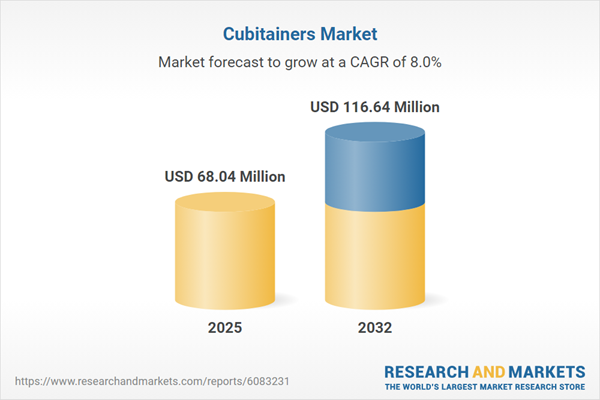Speak directly to the analyst to clarify any post sales queries you may have.
Cubitainers are transforming the bulk liquid supply chain by providing a modern solution that balances flexibility, compliance, and sustainability. For senior decision-makers, strategic insight into this evolving sector enables leaders to anticipate supply risks, align procurement strategies, and strengthen operational resilience. The cubitainers market merits careful evaluation within a landscape characterized by rapid innovation and dynamic regulatory shifts.
Market Snapshot: Cubitainers Market Size, Growth, and Forecast
The global cubitainers market achieved growth from USD 63.04 million in 2024 to USD 68.04 million in 2025, reflecting a 7.99% CAGR and is forecasted to reach USD 116.64 million by 2032. Cross-sector adoption, driven by supply chain optimization, the shift to sustainable packaging, and technological advancements, underpins this trajectory. Key industries—food and beverage, chemicals, pharmaceuticals, and cosmetics—are turning to cubitainers to drive efficiencies, support compliance, and adapt to evolving operational demands.
Cubitainers Market Scope & Segmentation
Thorough segmentation provides senior leaders with actionable insights to target investments and operational strategies within the cubitainers market. The following elements define the market’s landscape, supporting effective decision-making and business alignment.
- Container Types: Multi bag and single bag designs cater to unique fluid management needs across a diversity of industries.
- Material Types: Corrugated board, metal, and plastic constructions offer compatibility with sensitive contents and various supply chain requirements.
- Valve Designs: Drum valve, Luer lock, and spigot options enable precision dispensing, meeting both compliance protocols and specialized sector needs.
- Bag Materials: Metalized films, nylon, and polyethylene address chemical resistance, sustainability objectives, and durability considerations.
- Container Sizes: Ranges from 5–20 L, 20–50 L, 50–100 L, and over 100 L, meeting the distribution scales of both small-scale and industrial end-users.
- End-Use Applications: Chemical (including agricultural and industrial), cosmetics (such as color, hair, and skin care), food and beverage (spanning alcoholic, non-alcoholic, dairy, and condiments), and pharmaceuticals (covering healthcare and liquid formulations) highlight broad adoption and solution diversity.
- Geographic Reach: Americas (inclusive of North and South America), Europe, Middle East & Africa, and Asia-Pacific comprise distinct compliance needs and logistics dynamics, crucial for firms with cross-border operations.
- Market Participants: Key producers such as Liquibox LLC, Mondi Group Plc, Tetra Laval International S.A., Greif, Inc., Smurfit Kappa Group Plc, and Sonoco Products Company drive both competition and regional specialization.
Key Takeaways for Senior Leaders
- Sustainability-driven innovation is leading suppliers to introduce recyclable mono-material films and bio-based solutions, shaping procurement standards and competitive positioning.
- Digitalization enhances tracking and compliance, utilizing RFID tags and sensor technology for heightened operational transparency in procurement and logistics management.
- Protective multilayer films are under increasing demand, helping to safeguard sensitive and hazardous goods in advanced pharmaceutical and chemical supply chains.
- Automation—including robotic filling lines and automated palletizing—improves process efficiency, reduces manual error, and advances workplace safety protocols.
- Tailored segmentation by capacity, application, and valve design empowers companies to fulfill customer-specific requirements and bridge market gaps effectively.
- Strategic alliances and acquisitions are accelerating technological enhancements, such as improved seal integrity and IoT integration, directly impacting value delivery and product performance.
Tariff Impact: Navigating United States 2025 Policy Shifts
The introduction of 2025 US tariffs on polymers and select manufacturing tools has prompted manufacturers to reprioritize sourcing preferences, frequently opting for domestic alternatives at the expense of certain material attributes. This shift has encouraged the adoption of localized assembly and renewed focus on global partnerships, prompting revisions in supplier agreements and cost structures. Enhanced collaboration with logistics providers is facilitating continuity and reducing delays, supporting risk mitigation across the supply chain.
Methodology & Data Sources
This analysis integrates interviews with industry experts, plant managers, and regulatory officials, and supplements findings with a comprehensive secondary review including trade publications, patent records, and sustainability research. Historic shipment statistics and peer-reviewed studies enhance the credibility and accuracy of the market intelligence provided.
Why This Report Matters
- Supports senior executives in resource allocation and investment prioritization, anchored in supplier analysis, understanding of regional markets, and technological adoption trends.
- Delivers actionable intelligence for scenario planning, enabling alignment with shifting customer demands and readiness for future procurement or supply chain disruptions.
- Equips executive teams with targeted context to assess regulatory, operational, and partnership risks, crucial for integrated supply chain and procurement strategies.
Conclusion
The cubitainers market is advancing through the convergence of sustainability, digital innovation, and industry collaboration. Senior executives who act on these trends will enhance resilience and achieve new levels of value across global liquid supply chains.
Table of Contents
3. Executive Summary
4. Market Overview
7. Cumulative Impact of Artificial Intelligence 2025
Companies Mentioned
The companies profiled in this Cubitainers market report include:- Liquibox LLC
- Mondi Group Plc
- Tetra Laval International S.A.
- Greif, Inc.
- Smurfit Kappa Group Plc
- Sonoco Products Company
Table Information
| Report Attribute | Details |
|---|---|
| No. of Pages | 196 |
| Published | October 2025 |
| Forecast Period | 2025 - 2032 |
| Estimated Market Value ( USD | $ 68.04 Million |
| Forecasted Market Value ( USD | $ 116.64 Million |
| Compound Annual Growth Rate | 7.9% |
| Regions Covered | Global |
| No. of Companies Mentioned | 7 |









